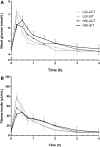Effects of breaking up prolonged sitting following low and high glycaemic index breakfast consumption on glucose and insulin concentrations
- PMID: 28500416
- PMCID: PMC5486571
- DOI: 10.1007/s00421-017-3610-4
Effects of breaking up prolonged sitting following low and high glycaemic index breakfast consumption on glucose and insulin concentrations
Abstract
Purpose: Breaking up prolonged sitting can attenuate the postprandial rise in glucose and insulin. Whether such effects are dependent of the glycaemic index (GI) of the consumed carbohydrate is unknown. This study examined the acute effects of breaking up prolonged sitting following a low GI and a high GI breakfast on postprandial glucose and insulin concentrations.
Procedures: Fourteen adult males aged 22.1 ± 1.2 years completed four, 4 h experimental conditions: high GI breakfast followed by uninterrupted sitting (HGI-SIT), low GI breakfast followed by uninterrupted sitting (LGI-SIT), high GI breakfast followed by 2 min activity breaks every 20 min (HGI-ACT), and low GI breakfast followed by 2 min activity breaks every 20 min (LGI-ACT). Positive incremental area under the curve (iAUC) for glucose and insulin (mean [95% CI]) for each 4 h experimental condition was calculated. Statistical analyses were completed using linear mixed models.
Results: The sitting × breakfast GI interaction was not significant for glucose positive iAUC (P = 0.119). Glucose positive iAUC (mmol/L 4 h-1) was significantly lower in the activity breaks conditions than the uninterrupted sitting conditions (2.07 [2.24, 2.89] vs. 2.56 [1.74, 2.40], respectively, P = 0.004) and significantly lower in the low GI conditions than the high GI conditions (2.13 [1.80, 2.45] vs. 2.51 [2.18, 2.84], respectively, P = 0.022). Insulin concentrations did not differ between conditions (P ≥ 0.203).
Conclusions: Breaking up prolonged sitting and lowering breakfast GI independently reduced postprandial glucose responses. This indicates that interrupting prolonged sitting and reducing dietary GI are beneficial approaches for reducing cardiometabolic disease risk.
Keywords: Cardiometabolic disease; Physical activity; Postprandial glucose; Postprandial insulin; Prolonged sitting; Sedentary behaviour.
Conflict of interest statement
Conflict of interest
The authors declare that they have no conflict of interest.
Ethical approval
All procedures performed in studies involving human participants were in accordance with the ethical standards of the institutional and/or national research committee and with the 1964 Helsinki declaration and its later amendments.
Informed consent
Informed consent was obtained from all individual participants included in the study.
Figures


Similar articles
-
Beneficial postprandial lipaemic effects of interrupting sedentary time with high-intensity physical activity versus a continuous moderate-intensity physical activity bout: A randomised crossover trial.J Sci Med Sport. 2018 Dec;21(12):1250-1255. doi: 10.1016/j.jsams.2018.05.022. Epub 2018 May 31. J Sci Med Sport. 2018. PMID: 29895406 Clinical Trial.
-
Interrupting prolonged sitting with repeated chair stands or short walks reduces postprandial insulinemia in healthy adults.J Appl Physiol (1985). 2021 Jan 1;130(1):104-113. doi: 10.1152/japplphysiol.00796.2020. Epub 2020 Nov 12. J Appl Physiol (1985). 2021. PMID: 33180640
-
Fitness Moderates Glycemic Responses to Sitting and Light Activity Breaks.Med Sci Sports Exerc. 2017 Nov;49(11):2216-2222. doi: 10.1249/MSS.0000000000001338. Med Sci Sports Exerc. 2017. PMID: 28594657 Clinical Trial.
-
Lowering breakfast glycemic index and glycemic load attenuates postprandial glycemic response: A systematically searched meta-analysis of randomized controlled trials.Nutrition. 2020 Mar;71:110634. doi: 10.1016/j.nut.2019.110634. Epub 2019 Nov 1. Nutrition. 2020. PMID: 31838460
-
Effects of Interrupting Prolonged Sitting with Physical Activity Breaks on Blood Glucose, Insulin and Triacylglycerol Measures: A Systematic Review and Meta-analysis.Sports Med. 2020 Feb;50(2):295-330. doi: 10.1007/s40279-019-01183-w. Sports Med. 2020. PMID: 31552570 Free PMC article.
Cited by
-
Breaking up prolonged sitting with moderate-intensity walking improves attention and executive function in Qatari females.PLoS One. 2019 Jul 12;14(7):e0219565. doi: 10.1371/journal.pone.0219565. eCollection 2019. PLoS One. 2019. PMID: 31299061 Free PMC article.
-
Prolonged sitting and peripheral vascular function: potential mechanisms and methodological considerations.J Appl Physiol (1985). 2023 Apr 1;134(4):810-822. doi: 10.1152/japplphysiol.00730.2022. Epub 2023 Feb 16. J Appl Physiol (1985). 2023. PMID: 36794688 Free PMC article. Review.
-
The Acute Metabolic and Vascular Impact of Interrupting Prolonged Sitting: A Systematic Review and Meta-Analysis.Sports Med. 2018 Oct;48(10):2347-2366. doi: 10.1007/s40279-018-0963-8. Sports Med. 2018. PMID: 30078066
-
Cardiovascular disease risk marker responses to breaking up prolonged sedentary time in individuals with paraplegia: the Spinal Cord Injury Move More (SCIMM) randomised crossover laboratory trial protocol.BMJ Open. 2018 Jun 22;8(6):e021936. doi: 10.1136/bmjopen-2018-021936. BMJ Open. 2018. PMID: 29934392 Free PMC article.
-
Is long-bout sedentary behaviour associated with long-term glucose levels 3 months after acute ischaemic stroke? A prospective observational cohort study.BMJ Open. 2020 Nov 26;10(11):e037475. doi: 10.1136/bmjopen-2020-037475. BMJ Open. 2020. PMID: 33243789 Free PMC article.
References
-
- Bailey DP, Broom DR, Chrismas BC, Taylor L, Flynn E, Hough J. Breaking up prolonged sitting time with walking does not affect appetite or gut hormone concentrations but does induce an energy deficit and suppresses postprandial glycaemia in sedentary adults. Appl Physiol Nutr Metab. 2016;41:324–331. doi: 10.1139/apnm-2015-0462. - DOI - PubMed
-
- Borg GA. Psychophysical bases of perceived exertion. Med Sci Sports Exerc. 1982;14:377–381. - PubMed
Publication types
MeSH terms
Substances
LinkOut - more resources
Full Text Sources
Other Literature Sources
Medical

